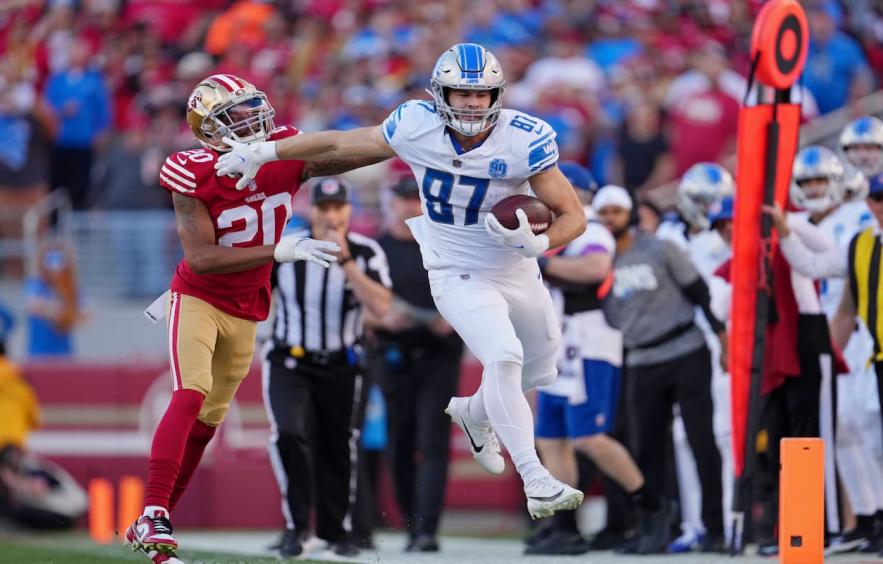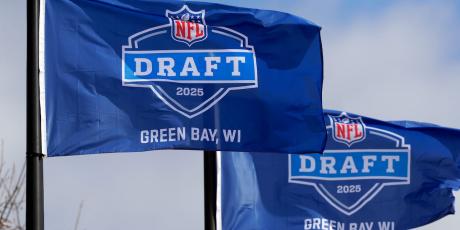Understanding Tight End Value in TE-Premium Fantasy Leagues & FFPC

It’s pretty easy to be overwhelmed by a new scoring system in fantasy football. Most people play in either standard or point-per-reception (PPR) fantasy leagues and have a basic understanding of the relative importance of a tight end. As the popularity of the FFPC and tight end premium leagues continues to blossom, it’s important to dive into the nuances of tight end premium scoring (1.5 points per reception) and how it should impact your strategy.
Understanding Tight End Value in TE Premium Leagues

FREE All-Inclusive 4for4 Subscription

FREE All-Inclusive 4for4 Subscription
How much does TE premium impact tight end scoring?
The easiest way to analyze how TE premium impacts scoring is by breaking down the past few years and comparing it to PPR scoring. One way I like to analyze value is by looking at how the top-scoring player at the position performed against the lowest-scoring player that should be starting in the league size you are playing in.
For example, how much did the overall TE1 outscore the TE12 (in a 12-man league)? This is how long-time fantasy analysts have derived "value" and formed the “TE1, TE2, TE3” tiers. This is because most leagues have 12 teams, so in a vacuum, each team is starting one of the top 12 tight ends. So you are comparing how much “value” the best tight end brings you against what should hypothetically be the worst starting tight end.
| PPR | TE Premium | |||||
|---|---|---|---|---|---|---|
| Year | TE1 | TE12 | Difference | TE1 | TE12 | Difference |
| 2023 | 239 | 143.5 | 95.5 | 291.3 | 165.8 | 125.5 |
| 2022 | 316.3 | 141.2 | 175.1 | 372.3 | 168.5 | 203.8 |
| 2021 | 301 | 159 | 142 | 354.6 | 188.6 | 166 |
| 2020 | 312.8 | 145.3 | 167.5 | 367.3 | 174.5 | 192.8 |
| 2019 | 256 | 138 | 118 | 304 | 163 | 141 |
| 2018 | 296 | 130 | 166 | 348 | 156 | 192 |
| 2017 | 235 | 134 | 101 | 277 | 161 | 116 |
| 2016 | 221 | 149 | 72 | 263 | 176 | 87 |
| 2015 | 255 | 149 | 106 | 291 | 177 | 114 |
The results were about as expected—in each of the last 9 seasons, the top-scoring TE has outscored the last “startable” tight end by more points in tight end premium scoring than PPR leagues. The gap between the best and least startable tight end becomes bigger. Outside of just raw scoring, this means that tight ends are more important in tight end premium leagues.
We saw a general rise in top tier tight end scoring after 2017 with a peak during 2020-2022. 2023 saw the lowest-scoring output for the tight end position since 2017 with the TE1 scoring just 291 points.
The increase during 2018-2022 may have had to do with the dominance of Travis Kelce and Mark Andrews who had historically great seasons. Despite their dwindling dominance, the tight end position still out-scored the last startable options (again, in a vacuum) at a healthy clip. Digging into other positions helps us understand the relative importance.
Tight End Premium Value vs Running Backs & Wide Receivers
Does the value-based argument of top-scoring tight ends hold up against other positions? Since you start two running backs, two wide receivers, and one tight end in FFPC leagues, we are comparing the No. 1 player at the position to the 24th instead of the 12th for tight ends.
| Wide Receiver | Running Back | ||||||||
|---|---|---|---|---|---|---|---|---|---|
| Year | TE1 | TE12 | Difference | WR1 | WR24 | Difference | RB1 | RB24 | Difference |
| 2023 | 291.3 | 165.8 | 125.5 | 403.2 | 218.6 | 184.6 | 391.3 | 190.7 | 200.6 |
| 2022 | 372.3 | 168.5 | 203.8 | 368.5 | 199.1 | 169.4 | 372.7 | 177.7 | 195 |
| 2021 | 354.6 | 188.6 | 166 | 439.5 | 219.7 | 219.8 | 373.1 | 173.9 | 199.2 |
| 2020 | 367.3 | 174.5 | 192.8 | 358.4 | 212.1 | 146.3 | 377.8 | 168.5 | 209.3 |
| 2019 | 304 | 163 | 141 | 374 | 212 | 162 | 469 | 174 | 295 |
| 2018 | 348 | 156 | 192 | 337 | 188 | 149 | 383 | 173 | 210 |
| 2017 | 277 | 161 | 116 | 311 | 188 | 123 | 387 | 166 | 221 |
| 2016 | 263 | 176 | 87 | 307 | 200 | 107 | 411 | 162 | 249 |
| 2015 | 291 | 177 | 114 | 382 | 211 | 171 | 320 | 164 | 156 |
| AVERAGE | 318.7 | 170.0 | 148.7 | 364.5 | 205.4 | 159.1 | 387.2 | 172.2 | 215.0 |
Some of this analysis is skewed by a player having a record season (See 2019 RB1 Christian McCaffrey who was a league-winner as a top pick) but the overall thought behind shooting for a player that could achieve the positional No.1 season is valid. What’s noticeable is how close wide receivers and tight ends are in this study in their average difference between the #1 and last startable player (148.7 vs 159.1). The most actionable piece of this data relates to this idea. If WRs and TEs are this close in positional value, should people really be flexing wide receivers as frequently as they are?
After drafting in the FFPC main event for the last 5+ years, anecdotally I have noticed some of the sharpest players being open to drafting two elite tight ends or aiming to flex a tight end more frequently than the average player.
Right now according to FFPC Main event ADP, 24 WRs are coming off the board right after the seventh tight end has come off the board. The 12th tight end has an ADP of 91.5. This is the same ADP as the WR41/42. I don’t know if these should match up since each player has unique circumstances, projections, and range of outcomes, but holistically, it’s worth noting this discrepancy. Especially as you get into the late single-digit rounds, there could be an opportunity to draft a flex-viable tight end over a fourth wideout.
Projecting Tight Ends in 2024
Our projections are very conservative for the 2024 season with Sam LaPorta clocking in at TE1 with 266 points in TE premium. With that being said, he is projected for more points than all but four wideouts this year, yet his ADP is almost 8 picks after. Since we know the difference in replacement value between the two positions is marginal at best, taking a tight end higher than consensus could start as soon as the late first round.
The Bottom Line
- Don’t be afraid to take elite tight ends as early as the 1st-2nd round turn.
- Loading up on high-upside tight ends can win your league. Sam LaPorta was a late-round option last year and was a league-winner in this scoring format last season
- Pairing an early-round tight end with a bunch of late-round options is a good option in FFPC leagues because you can put one in the flex spot if they pan out, which can reap big rewards.





















